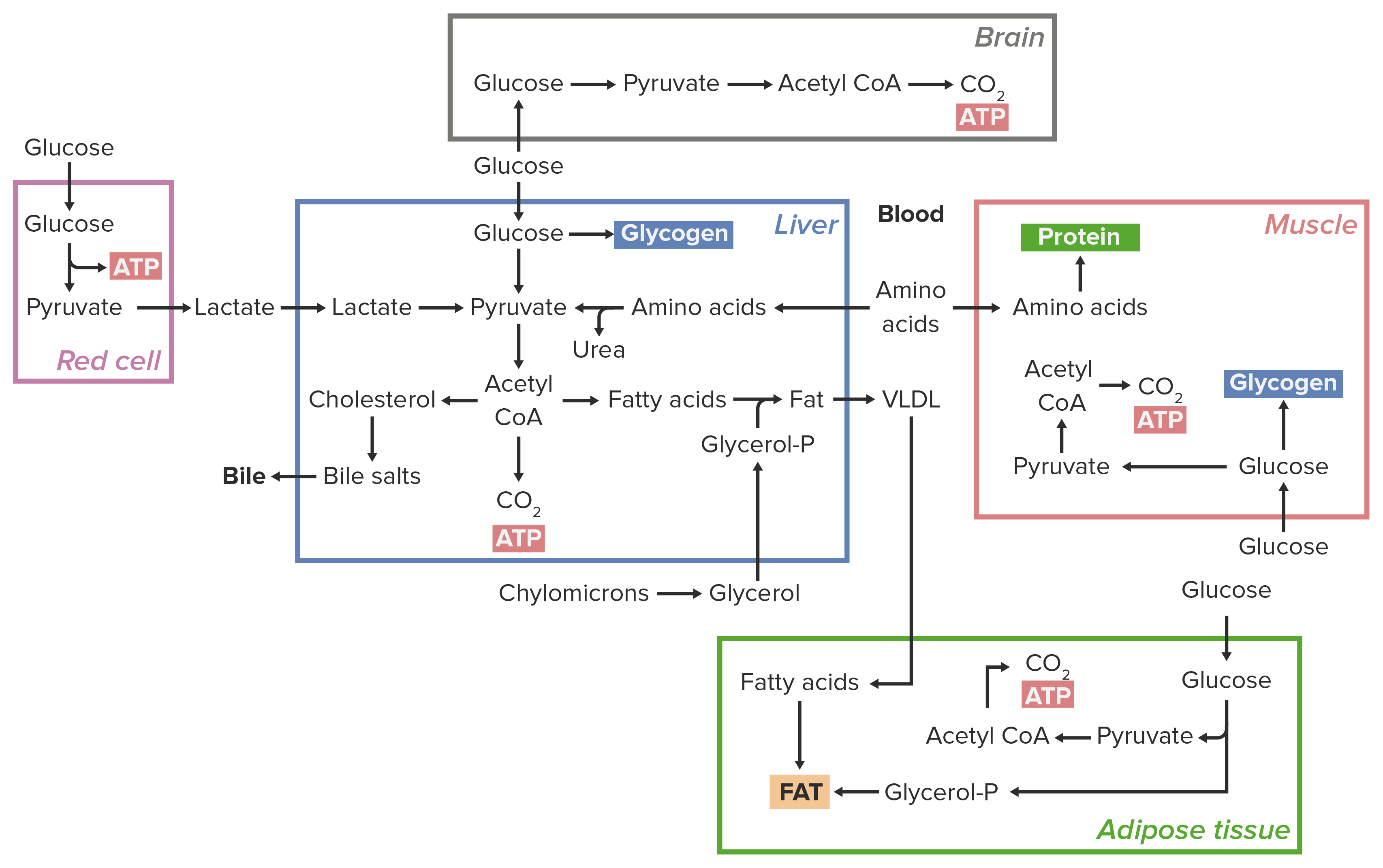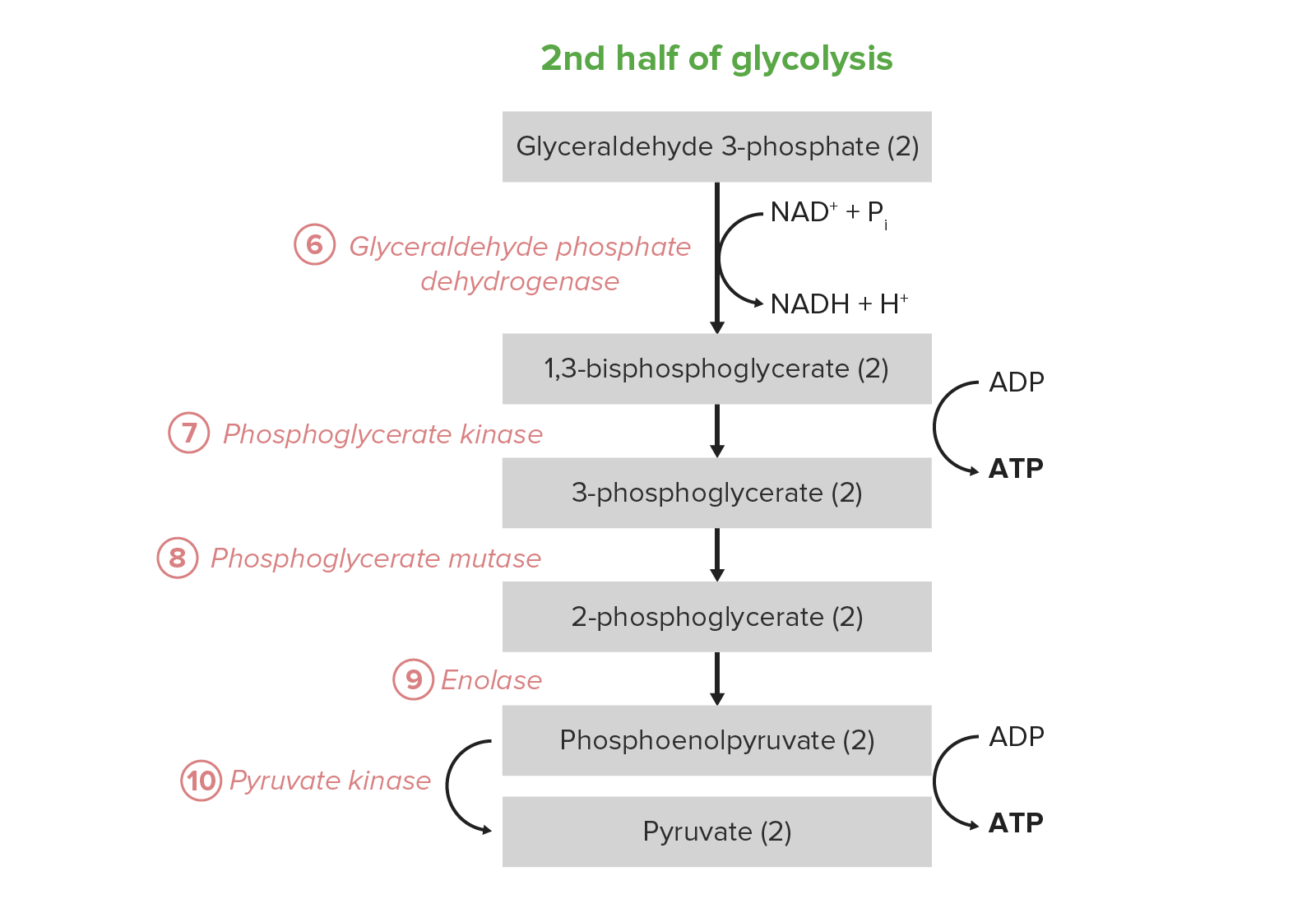Playlist
Show Playlist
Hide Playlist
Pyruvate Oxidation and Glycolysis: Overview
-
Slides 14 GlycolysisPyruvate oxidation CellBiology.pdf
-
Download Lecture Overview
00:00 In this lecture we'll be looking at glycolysis and pyruvate oxidation, the first two phases. 00:06 So by the end of the lecture, you should be able to describe some of the processes involved in glycolysis as well as probably calculate the average energy yield from glycolysis and distinguish between aerobic and anaerobic respiration. 00:25 And finally you should be able to discuss the purpose of pyruvate oxidation piece. 00:32 So, moving into the whole process, we will start thinking about what glycolysis means. 00:40 Glycolysis means specifically glycol-lysis; to split glucose into two. 00:47 So that's exactly what we do. 00:48 Glucose is a six carbon molecule and we are going to split it into two three-carbon molecules. 00:54 We're not gonna get too involved in the details. 00:57 Basically I'm gonna give you an overview and some accounting to keep track of how much ATP is produced in each stage, as well as how many electron carriers are filled in each stage. 01:12 And then we'll keep track of carbons. Where do all these carbons go? You may recall that previously we have spoken about the idea of high energy containing bonds that are in glucose. 01:26 So we have carbons strung to carbons. 01:28 And in the process of cell respiration, we're going to break these bonds so we're going to split carbons off, steal the electrons and take those electrons to the electron transport chain and chemiosmosis where we produce the major amount of ATP that we use to run daily processes. 01:47 So first of all, glycolysis, the splitting of sugar and then preparing those two pyruvate molecules to enter the Krebs cycle. 01:56 Glycolysis is converting again our six carbon sugar into two three-carbon pyruvates. 02:04 So we're tracking carbons there. We've still got six carbons at the end of glycolysis. 02:10 Here's the overall process. A little bit more detailed than we need to know. 02:14 When you look into your biochemistry course you'll start learning the name of every enzyme involved in each step of the pathway. 02:21 And you'll also probably learn all the intermediates. 02:24 And, you might even learn specifically how those electrons move around in the enzymes. 02:29 But for the purposes of this course, you'll be introduced to, again sort of the accounting and the general process. 02:37 So there's two phases that we'll split glycolysis into. 02:40 The first one is an energy investment phase. 02:43 You'll recall that I made the analogy of burning a piece of wood because glucose is the same thing as wood essentially. 02:51 It's just the beta form of bonds that we're unable to break. 02:55 But if we light it on fire, it undergoes a similar process but much more rapid and so we combust the wood all at once. 03:02 But in order to get that wood started, we need to light a match. 03:07 We need to give it a lighter. 03:08 We need to maybe prepare it a little bit and give it some energy. 03:12 So, just the same thing happens when we metabolize glucose we have an energy investment phase. 03:18 So two ATP go in for each pyruvate that we oxidize. 03:23 Two ATP come in, they come out as ADP and they're ready to be phosphorylated again later in the process. 03:30 But we split glucose in this energy investment phase, so it sorta takes energy to pop those glucoses apart. You can think of it that way. 03:40 During the energy harvesting phase, we'll actually get some ATP yield as well as load up some of those taxis that I introduced you to in the last lecture. 03:49 You'll recall the taxis are an analogy for the electron carriers. 03:53 So in this case we'll have NADs that are going to pick up electrons and hydrogen. 03:59 Recall the electrons and hydrogens who are like couples, very excited to go to the school dance. 04:05 They're on their way to prom. 04:06 They need to get in a taxi or they need to get in the limousine, whichever vehicle they choose in order to get to the prom. 04:12 And we're gonna carry these kids all the way to the prom which is the very last phase of cellular respiration. 04:19 So we'll continue the analogy all the way through. 04:22 So, now we've got our six carbon sugars split into two carbon -- two three-carbon pyruvates. 04:29 We'll see that the yield is two ATP, one for -- or two ATP for each pyruvate. 04:36 So, four total ATP as well as NADH. So we've added some electrons to the cars. 04:43 So, NADH, two NAD's become two NADH's because they're caring two electrons and hydrogens always carry with the electrons so two hydrogens in addition. 04:57 And then we'll have four ATP produced and that is by substrate level phosphorylation. 05:04 There's the enzyme that comes along and picks up the ADP, adds a phosphate. 05:09 So, substrate level meaning it actually physically joins in an enzyme. 05:14 So, the substrate again being ADP adding one phosphate to make it ATP. 05:20 So, we have two ATPs invested and we've yielded four. 05:28 So truly we've only made two ATP. 05:32 And that's all we're going to get in glycolysis, two ATP from the whole process. 05:38 And many organisms only undergo glycolysis. 05:42 They don't actually have any of the further processes. 05:45 So, glycolysis relatively yields a very small amount of ATP. 05:51 But we do still have two three-carbon pyruvates at the end of it which means we have more carbons to split apart further on down the line and yield a ton more ATP. 06:02 So, let's move into looking at the summary of glycolysis. 06:09 In glycolysis, this figure is all you need to know in one little figure. 06:14 So we have glucose, energy investment, energy released. 06:18 We end up with two three-carbon pyruvates. 06:21 We've got two NADHs and we've got two ATP net.
About the Lecture
The lecture Pyruvate Oxidation and Glycolysis: Overview by Georgina Cornwall, PhD is from the course Energy, Enzymes and Metabolism.
Included Quiz Questions
Which of the following molecules is produced by glycolysis?
- Pyruvate
- Glycogen
- Amino acid
- Starch
- Oxalate
What is the ATP gain after a glucose molecule undergoes glycolysis?
- 2
- 6
- 10
- 32
- 8
Which of the following molecules is considered an electron-carrying molecule?
- NADH
- Pyruvate
- Glucose
- ATP
- 3-Phosphoglyceraldehyde
Customer reviews
5,0 of 5 stars
| 5 Stars |
|
5 |
| 4 Stars |
|
0 |
| 3 Stars |
|
0 |
| 2 Stars |
|
0 |
| 1 Star |
|
0 |





